Discover biblical ghost stories that challenge traditional views and uncover the supernatural within sacred texts.

Are There Ghosts in the Bible
When you think of ghosts, the Bible might not be the first source that comes to mind, yet the story of Saul and the Witch of Endor in 1 Samuel 28 offers a compelling narrative of an apparition. This ancient text blurs the lines between the divine, the dead, and the mysterious, challenging modern perceptions of biblical spirits.
As you explore further, you'll find that this isn't an isolated incident; both the Old and New Testaments are sprinkled with encounters that might make you question the traditional understanding of ghosts.
What other passages might shift your perspective? Let's find out.
Key Takeaways
- The Bible includes spirits such as ghosts, angels, and demons, indicating a belief in their existence.
- Biblical narratives often use apparitions to convey spiritual truths and ethical messages.
- The story of Saul and the Witch of Endor directly addresses the concept of ghosts by summoning the spirit of the prophet Samuel.
- Supernatural occurrences in the Bible, including those that might be interpreted as ghostly, are used to underscore moral and theological points.
Defining Biblical Spirits
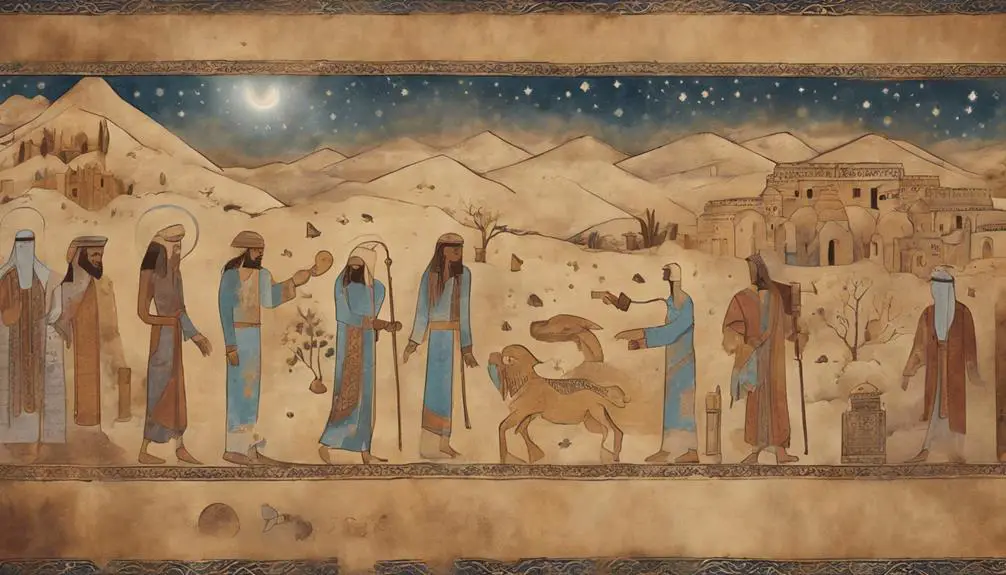
In the context of the Bible, 'spirits' refer to a range of entities, including ghosts, angels, and demons, each with distinct roles and characteristics within the scriptural narrative. You'll find that these spirits are often interconnected with the spiritual realm, a dimension that exists alongside the physical world yet remains invisible to the human eye. This realm isn't just a backdrop but plays a critical role in the unfolding of biblical events, influencing both the material world and the individual's internal state.
Angelic appearances, for instance, are pivotal moments within the Bible, where the spiritual realm directly intersects with human affairs. These celestial beings serve as messengers of God, tasked with delivering divine messages, offering guidance, or providing protection to people. Their presence underscores the close relationship between the spiritual and physical worlds, demonstrating how the divine can manifest within the human experience.
Analyzing these spiritual entities and their appearances provides a deeper understanding of the complex nature of the biblical narrative. It reveals a multilayered universe where the spiritual and the material coexist, each influencing the other in profound ways.
Old Testament Apparitions
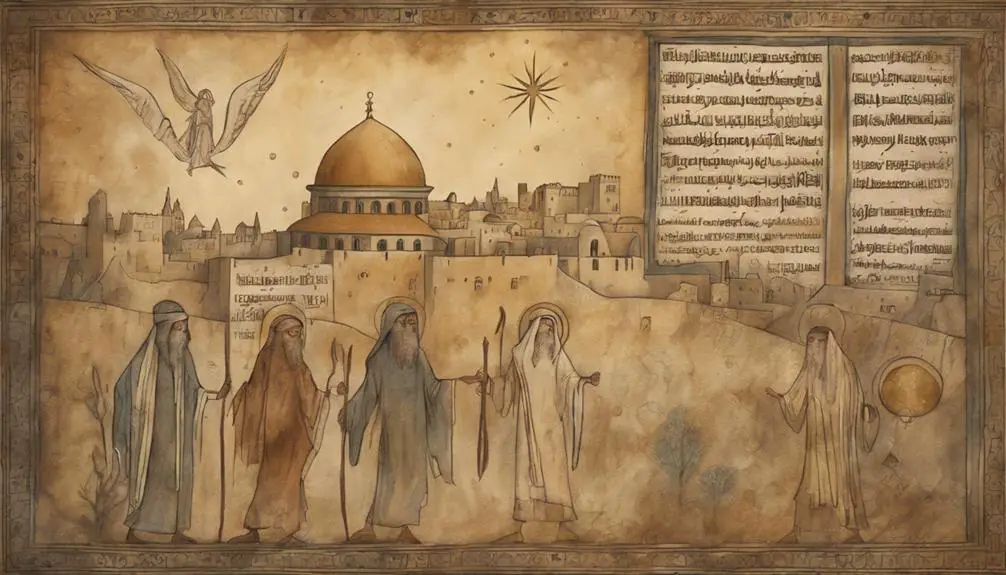
Reflecting on the rich tapestry of spiritual entities in the Bible, it's crucial to explore specific instances of apparitions within the Old Testament and their profound implications on both the narrative and its characters. The presence of garden serpents and Cherubim guardians stands out as significant examples, each embodying complex theological and ethical themes.
The Garden of Eden introduces the serpent, not merely a physical creature but a symbol of temptation and the introduction of sin into the world. This apparition's interaction with Adam and Eve sets the stage for humanity's moral journey, emphasizing the themes of innocence, temptation, and the consequences of disobedience.
Similarly, the Cherubim, tasked with guarding the entrance to Eden post-fall, represent a divine intervention that underscores themes of holiness and separation from the divine. Their role highlights the gravity of sin and the necessity of redemption, marking the space between the sacred and the profane.
These Old Testament apparitions aren't ghostly in the conventional sense but are pivotal in conveying deep spiritual truths. Through them, the narrative delves into the complexities of human nature, divine justice, and the ongoing quest for redemption.
New Testament Encounters
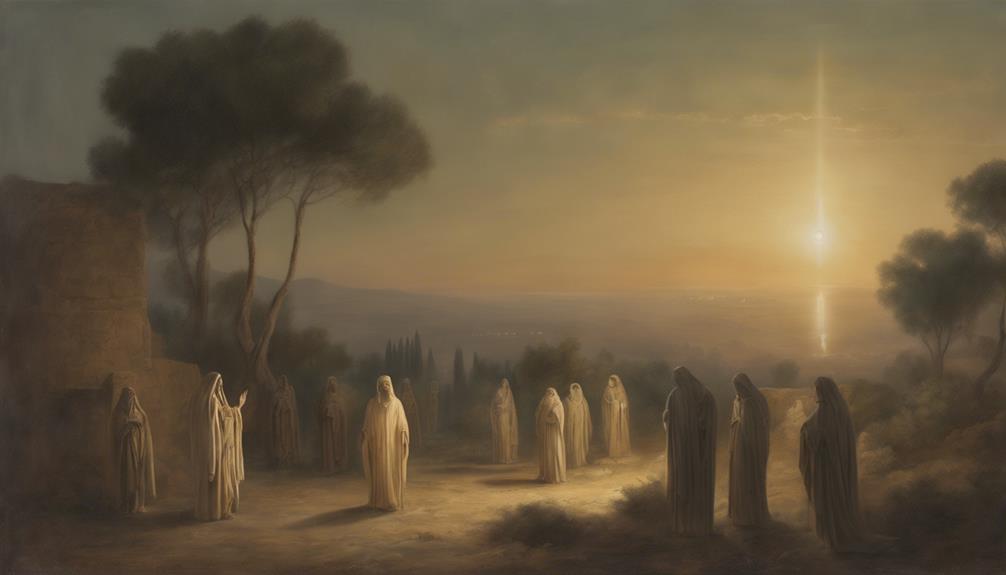
Several noteworthy encounters with spiritual beings in the New Testament offer insights into the evolving nature of divine interaction with humanity. One of the most striking episodes involves Jesus' walk on water, a moment that initially incites fear among the disciples. They mistake him for a ghost, a reaction that underscores the prevailing beliefs and fears regarding spirits at the time. This incident not only reveals the disciples' fear but also Jesus' role in redefining the understanding of spiritual beings and their interactions with humans.
Passage |
Significance |
|---|---|
Matthew 14:25-27 |
Jesus walks on water, initially frightening the disciples who mistake him for a ghost. |
Luke 24:36-39 |
After his resurrection, Jesus appears to his disciples, who are startled and frightened, thinking they see a ghost. |
Acts 12:6-15 |
Peter's miraculous escape from prison is initially dismissed by fellow believers; they suggest it's his angel, reflecting beliefs in spiritual presences. |
Acts 19:11-12 |
Extraordinary miracles by Paul suggest a divine power at work, challenging contemporary understandings of the spiritual realm. |
These encounters highlight a transition in how spiritual phenomena are perceived and interacted with, moving from fear towards a deeper understanding of the divine's presence and power in the world.
Saul and the Witch of Endor
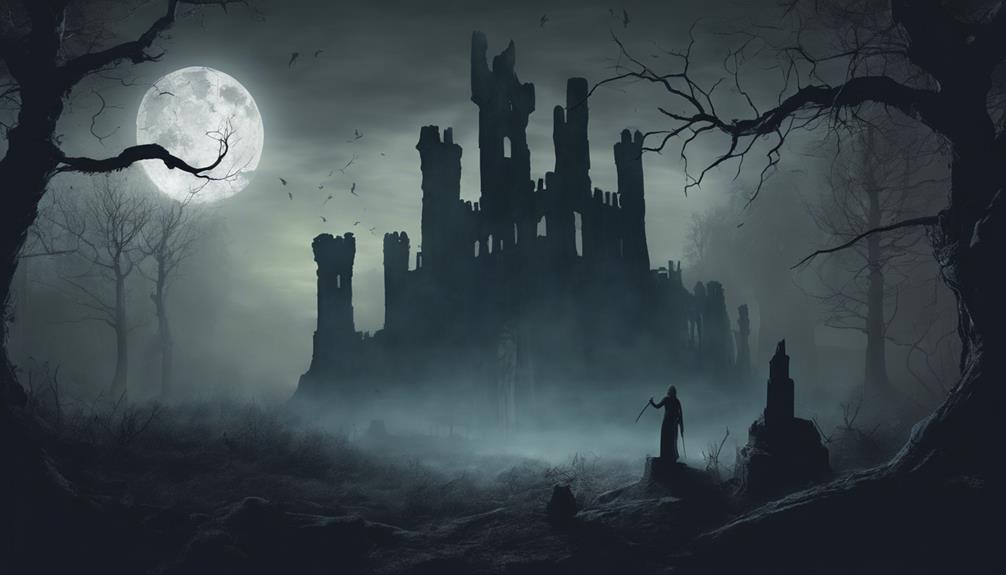
Frequently, biblical narratives confront the complex relationship between humanity and the divine, as vividly illustrated by the story of Saul consulting the Witch of Endor. This narrative, deeply embedded within the historical context of ancient Israel, showcases a pivotal moment where King Saul, in desperation, seeks guidance from a practitioner of necromancy, despite its explicit prohibition under Mosaic Law. The ethics of necromancy, as portrayed in this account, highlight a moral and spiritual dilemma faced by Saul, reflecting broader questions about the legitimacy and morality of seeking knowledge from the dead.
The encounter with the Witch of Endor not only serves as a cautionary tale against the transgression of divine commandments but also provides a unique lens through which to examine the ancient Israelites' beliefs concerning the afterlife and the supernatural. The historical context of this story is crucial for understanding its significance, as it occurs at a time when Saul's kingship is faltering, and he's grappling with the loss of divine favor. This context underscores the desperation that drives Saul towards such a forbidden act, illustrating the complexities of human-divine relationships and the ethical boundaries they entail.
Analyzing Ghostly Interpretations
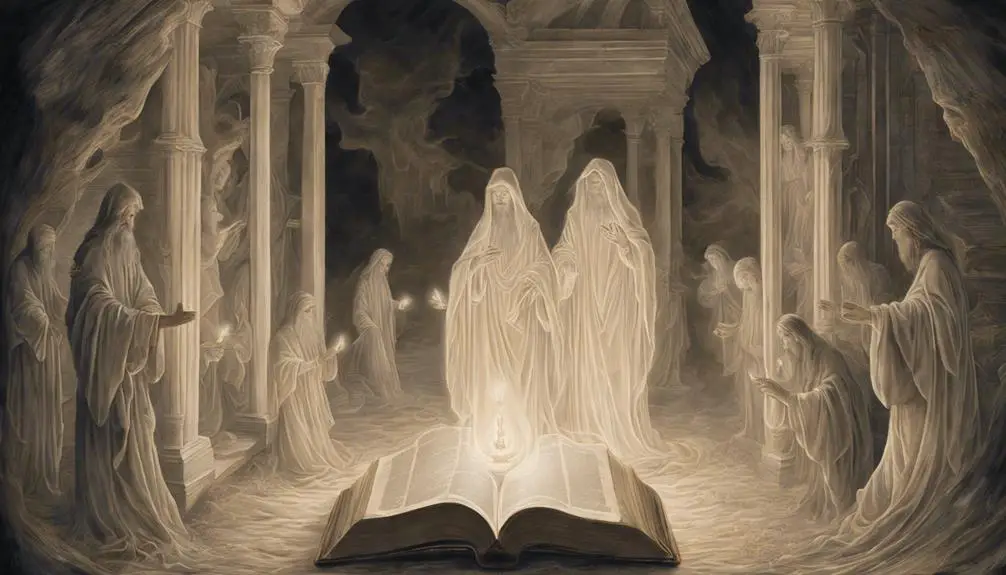
Exploring ghostly interpretations within biblical narratives challenges us to reconsider the boundaries between the living and the supernatural. As you delve into the texts, it becomes evident that cultural perceptions significantly influence the understanding of supernatural phenomena. The Bible, a collection of writings spanning various periods and cultures, offers a rich tapestry for examining how ancient societies conceptualized ghosts and the afterlife.
Analyzing these scriptural accounts requires a discerning eye. You must navigate the nuanced language and historical context to unearth the layers of meaning embedded within. For instance, the portrayal of spirits or apparitions in biblical times often reflects the contemporary beliefs and fears surrounding death and the unknown. This exploration not only enlightens us about past attitudes towards the supernatural but also prompts us to question how our current cultural lens shapes our interpretations.
Moreover, the role of supernatural phenomena in these ancient texts often serves to underscore moral or theological points, rather than simply to recount ghost stories. This critical perspective allows you to appreciate the complexity of biblical narratives, where the spiritual realm intersects with human experience in profound ways. Through this lens, the Bible reveals itself as a document rich in cultural and spiritual insights, challenging us to rethink our preconceptions of the supernatural.
Frequently Asked Questions
How Do Contemporary Religious Leaders Across Different Denominations Interpret the Concept of Ghosts or Spirits in Relation to Biblical Texts?
You'll find that contemporary religious leaders vary in their views on ghosts or spirits, heavily influenced by denominational perspectives. Their spiritual interpretations often reflect a diverse range of beliefs about the afterlife, as outlined in biblical texts.
Some may see spirits as manifestations of the deceased, while others interpret them more symbolically. This diversity underscores the complexity of bridging ancient scripture with modern understanding, making it a rich area for scholarly exploration.
Are There Any Specific Prayers or Rituals Mentioned in the Bible for Protecting Oneself From Malevolent Spirits or Ghosts?
You're exploring if the Bible mentions specific prayers or rituals for protection against malevolent spirits or ghosts.
While not directly addressing ghostly encounters, it does offer guidance on spiritual protection. Ephesians 6:11-18, for example, advises donning the 'armor of God' to stand against evil forces.
This passage, among others, serves as a foundational text for Christians seeking spiritual safeguarding, rather than a ritualistic approach specifically targeting ghosts.
How Have Depictions of Ghosts in the Bible Influenced Modern Cultural Representations of Ghosts in Literature and Film?
You'll find that biblical depictions of ghosts have significantly influenced modern cultural representations, particularly in literature and film.
Through cinematic influences and literary adaptations, these ancient narratives shape how ghosts are portrayed, infusing them with moral and ethical complexities.
This interplay underscores a rich tradition of storytelling, where the spectral entities of the Bible are reimagined to explore themes of redemption, warning, and the metaphysical, profoundly impacting today's ghostly portrayals.
Can the Concept of Ghosts in the Bible Be Reconciled With the Beliefs About the Afterlife in Other Major World Religions?
You're exploring how ghosts, as presented in various texts, align with afterlife views across major religions. Through interfaith dialogues, you'll find that cultural syncretism allows these beliefs to coexist, sometimes harmoniously.
This approach reveals the complexity of integrating biblical ghost concepts with other religious afterlife beliefs. It's a testament to the shared human fascination with mortality and the unknown, bridging gaps between seemingly disparate spiritual narratives.
What Is the Historical Context Behind the Belief in Ghosts During the Times the Bible Was Written, and How Did It Affect People's Daily Lives and Spiritual Practices?
When examining the historical context behind ghost beliefs during biblical times, you'll find ancient burial rites and spiritual cleanliness at the core. These practices deeply influenced people's daily lives and spiritual outlooks.
Burial rites weren't just ceremonies; they were integral for ensuring a spirit's peaceful rest. Similarly, spiritual cleanliness was paramount, believed to protect the living from malevolent spirits.
This framework shaped a society profoundly aware of the spiritual realm's influence.
Conclusion
In conclusion, your exploration of ghosts in the Bible reveals a complex understanding of spiritual entities.
You've seen how both the Old and New Testaments present apparitions and encounters that reflect the era's spiritual beliefs.
The story of Saul and the Witch of Endor, particularly, underscores the nuanced biblical stance on the afterlife and spirit world.
Your analysis suggests that while the Bible doesn't explicitly confirm ghosts as understood today, it acknowledges the presence of supernatural beings and phenomena.


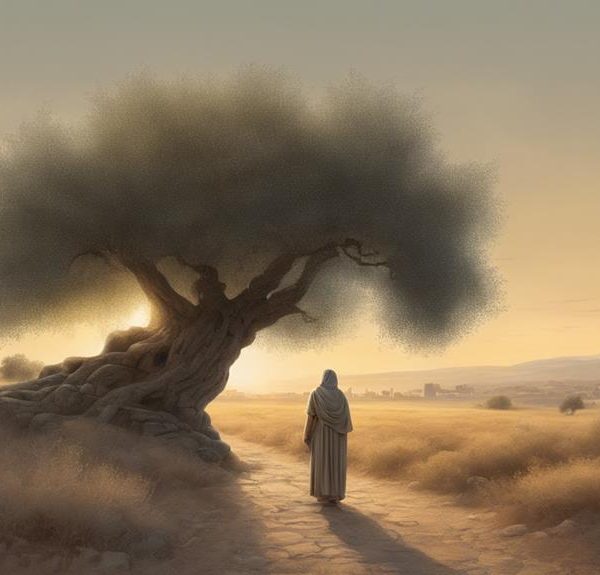
Sign up